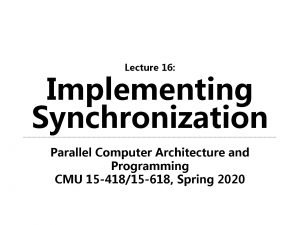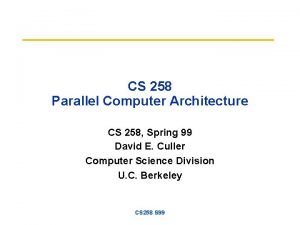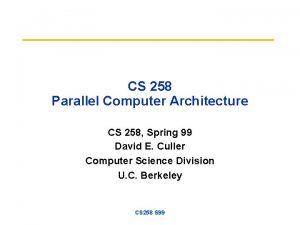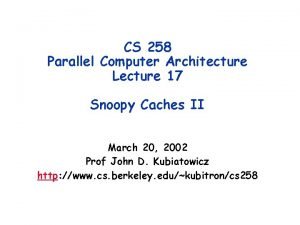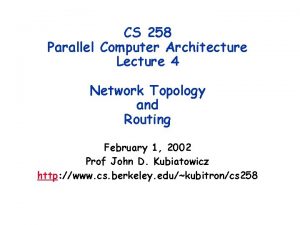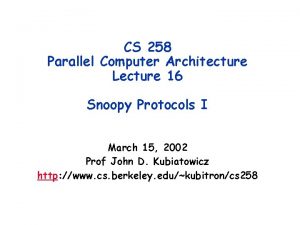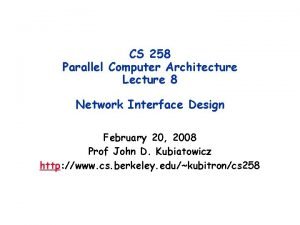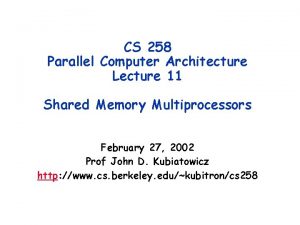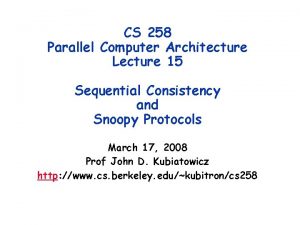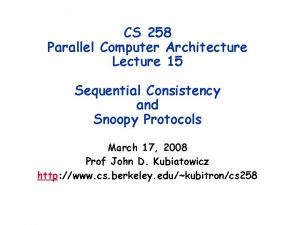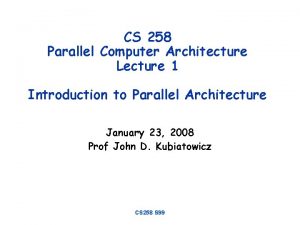CS 258 Parallel Computer Architecture Lecture 15 1







![Hardware cost of directory • [table 2 in the paper] • 13. 7% DRAM Hardware cost of directory • [table 2 in the paper] • 13. 7% DRAM](https://slidetodoc.com/presentation_image_h2/97e153ed6a188968886fc290f5ae1a44/image-8.jpg)




- Slides: 12

CS 258 Parallel Computer Architecture Lecture 15. 1 DASH: Directory Architecture for Shared memory Implementation, cost, performance Daniel Lenoski, et. al. “The DASH Prototype: Implementation and Performance”, Proceedings of the International symposium on Computer Architecture, 1992. March 17, 2008 Rhishikesh Limaye

DASH objectives • Demonstrates large-scale shared memory multiprocessor using directory-based cache coherence. • Prototype with 16 -64 processors. • Argument is that: for performance and programmability, a parallel architecture should: – Scale to 100 s-1000 s of processors – Have high performance individual processors – Have single shared address space 3/17/08 Kubiatowicz CS 258 ©UCB Spring 2008 Lec 15. 1. 2

Two-level architecture • Cluster: – Uses bus-based shared memory with snoopy cache coherence – 4 processors per cluster • Inter-cluster: – Scalable interconnect network – Directory-based cache coherence 3/17/08 Kubiatowicz CS 258 ©UCB Spring 2008 Lec 15. 1. 3

Cluster level • Minor modifications to off-the-shelf 4 D/340 cluster • 4 MIPS R 3000 processors + 4 R 3010 floating point coprocessors • L 1 write-through, L 2 write-back. • Cache coherence: – MESI i. e. Illinois » Cache-to-cache transfers good for cached remote locations – L 1 cache is write-through => inclusion property • Pipelined bus with maximum bandwidth 64 MB/s. 3/17/08 Kubiatowicz CS 258 ©UCB Spring 2008 Lec 15. 1. 4

Inter-cluster directory protocol • Three states per 16 B memory chunk: invalid, shared, dirty. • Memory is distributed across clusters. • Directory bits: – Simple scheme of 1 bit per cluster + 1 dirty bit. » This is good for the prototype which has maximum 16 clusters. Should be replaced by limited-pointer/sparse directory for more clusters. • Replies are sent directly between clusters and not through the home cluster. – i. e. invalidation acks are collected at the requester node and not the home node of a memory location. 3/17/08 Kubiatowicz CS 258 ©UCB Spring 2008 Lec 15. 1. 5

Extra hardware for directory For each cluster, we have the following: • Directory bits: DRAM – 17 bits per 16 -byte cache line • Directory controller: snoops every bus transaction within cluster, accesses directory bits and takes action. • Reply controller • Remote access cache: SRAM. 128 KB, 16 B line – – Snoops remote accesses on the local bus Stores state of on-going remote accesses made by local processors Lock-up free: handle multiple outstanding requests QUESTION: what happens if two remote requests collide in this direct mapped cache? • Pseudo-CPU: – for requests for local memory by remote nodes. • Performance monitor 3/17/08 Kubiatowicz CS 258 ©UCB Spring 2008 Lec 15. 1. 6

Memory performance • 4 -level memory hierarchy: (L 1, L 2), (local L 2 s + memory), directory home, remote cluster Best case MB/s Read from L 1 Worst case Clock/word MB/s Clock/word 133 1 Fill from L 2 30 4. 5 9 15 Fill from local bus 17 8 5 29 Fill from remote 5 26 1. 3 101 Fill from dirty remote 4 34 1 132 Write to cache 32 4 Write to local bus 18 7 8 17 Write to remote 5 25 1. 5 89 Write to dirty-remote 4 33 1 120 3/17/08 Kubiatowicz CS 258 ©UCB Spring 2008 Lec 15. 1. 7
![Hardware cost of directory table 2 in the paper 13 7 DRAM Hardware cost of directory • [table 2 in the paper] • 13. 7% DRAM](https://slidetodoc.com/presentation_image_h2/97e153ed6a188968886fc290f5ae1a44/image-8.jpg)
Hardware cost of directory • [table 2 in the paper] • 13. 7% DRAM – directory bits – For larger systems, sparse representation needed. • 10% SRAM – remote access cache • 20% logic gates – controllers and network interfaces • Clustering is important: – For uniprocessor node, directory logic is 44%. • Compare to message passing: – Message passing has about 10% logic + ~0 memory cost. – Thus, hardware coherence costs 10% more logic and 10% more memory. – Later argued that, the performance improvement is much greater than 10% -- 3 -4 X. 3/17/08 Kubiatowicz CS 258 ©UCB Spring 2008 Lec 15. 1. 8

Performance monitor • Configurable events. • SRAM-based counters: – 2 banks of 16 K x 32 SRAM. – Addressed by events (i. e. event 0, event 1, event 2… form address bit 0, 1, 2…) » Thus, can track (log 16 K) = 14 events with each bank. • Trace buffer made of DRAM: – Can store 2 M memory ops. – With software support, can log all memory operations. 3/17/08 Kubiatowicz CS 258 ©UCB Spring 2008 Lec 15. 1. 9

Performance results • 9 applications • Good speed-up on 5 – without specially optimizing for DASH. • MP 3 D has bad locality. PSIM 4 is enhanced version of MP 3 D. • Cholesky: more processors => too fine granularity, unless problem size is increased unreasonably. • Note: dip after P = 4. 3/17/08 Kubiatowicz CS 258 ©UCB Spring 2008 Lec 15. 1. 10

Detailed study of 3 applications • What to read from tables 4, 5, 6: Busy pclks between proc. stalls more => remote caching works, ability to hide memory latencies. Fraction of reads local, fraction of remote reads dirty-remote locality Bus, network utilization Higher utilization => congestion => higher latencies • Water and Locus. Route have equal fraction of reads local, but Water scales well, and Locus. Route doesn’t. • Remote caching works: • Water and Locus. Route have remote reference every 20 and 11 instructions, but busy pclks between processor stalls is 506 and 181. 3/17/08 Kubiatowicz CS 258 ©UCB Spring 2008 Lec 15. 1. 11

Conclusions • Locality is still important, because of higher remote latencies • However, for applications, natural locality can be enough (Barnes-Hut, Radiosity, Water). • Thus, good speed-ups can be achieved without difficult programming model (i. e. message passing) • For higher performance, have to worry about the extended memory hierarchy – but only for critical data structures. Analogous to argument in the uniprocessor world: caches vs. scratchpad memories/stream buffers. 3/17/08 Kubiatowicz CS 258 ©UCB Spring 2008 Lec 15. 1. 12
 Architecture lecture notes
Architecture lecture notes Computer architecture lecture
Computer architecture lecture 258 x 203
258 x 203 Section 258 of mlrc
Section 258 of mlrc Emily dickinson poem 258
Emily dickinson poem 258 The verbs ser and estar (p. 258) answers
The verbs ser and estar (p. 258) answers Iis leonardo da vinci roma
Iis leonardo da vinci roma Rd 258/99
Rd 258/99 Gog 258
Gog 258 01:640:244 lecture notes - lecture 15: plat, idah, farad
01:640:244 lecture notes - lecture 15: plat, idah, farad Parallel computer architecture cmu
Parallel computer architecture cmu Daisy chain priority interrupt
Daisy chain priority interrupt Bus architecture in computer architecture
Bus architecture in computer architecture










